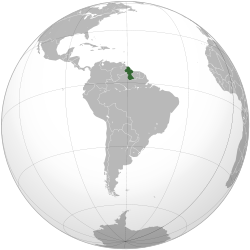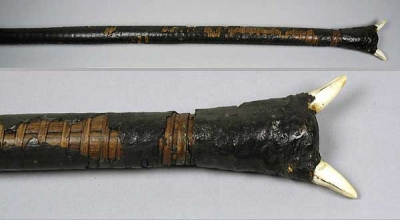Blowpipe (1884.140.905)
 GuianaBlowpipe from Guyana, Americas. Part of the Pitt Rivers Museum Founding Collection. Given to the Museum in 1884.
GuianaBlowpipe from Guyana, Americas. Part of the Pitt Rivers Museum Founding Collection. Given to the Museum in 1884.
This long (nearly 2 metres) blowpipe is known as a cura among the Macusi people of lowlands Guyana (formerly British Guiana), on the north-east coast of South America. It would have been used to hunt birds in trees and small game although the poisoned darts could be effective against humans too.
Form and Function
This Macusi blowpipe is constructed from two independently-carved half-tubes, which are sealed together and made airtight with resin, tightly bound with cane or bark strips, and overlaid with more gum. This is one of the two main ways of constructing a blowpipe. The other is by boring out a single piece of wood. This first method is technically more difficult, as the two separate halves must be carved to match very closely, in order to be airtight and shoot straight. However, this is sometimes the only option if the environment does not yield many large, single boughs.
The mouthpiece is very notable for the two large protruding teeth, between which the shooter places their mouth to fire. Although they may look like the fangs of a jaguar, or some other dangerous animal, they are actually the teeth of an agouti, a relation of the guinea pig. Agoutis can grow to the size of a small dog and they use these large blunt fangs to crack open Brazil nuts. In the highlands of Guiana, these Agouti teeth are known as the 'ears' (pana) of the blowpipe, and are attached with beeswax to the mouth. A blowpipe always warps and becomes bent over time, because the wood seasons, and the pipe's own weight bends it. As a solution to this problem, the pana exist to immediately show the shooter which direction his pipe is warped in, so that he can curve the pipe upwards. This gains him some additional range for his blow-dart, rather than losing him some, if the pipe were curved downwards.
The darts used are too light to cause much injury by impact alone. Instead they are tipped with poison which incapacitates or kills the prey. The Macusi use a poison called curare, which is scraped as shavings from a climbing vine known as Devildoer Rope. These are then soaked in water and the infused liquid is boiled into a syrupy substance. The active ingredient of curare is strychnine, famous from Agatha Christie and Conan Doyle novels. It has a paralysing effect on the voluntary nervous system. This causes the victim to become increasingly uncoordinated until eventually the muscles controlling breathing stop working. Death occurs by asphyxiation, usually within 15-45 minutes of poisoning.
The knowledge of manufacturing curare is not known to all lowlands South American peoples so the poison is a valuable commodity, traded in a hardened and dried form across large distances.





